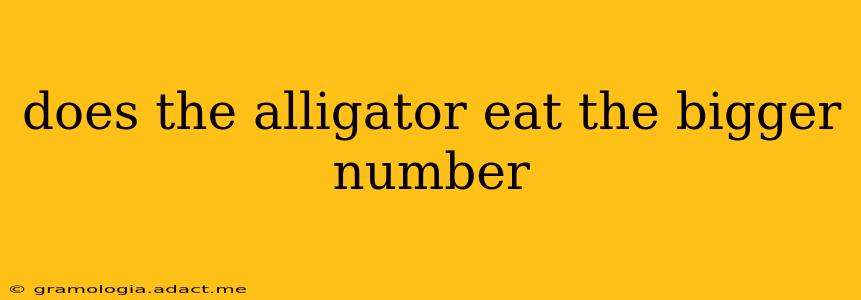Does the Alligator Eat the Bigger Number? A Fun Look at Number Comparison
The question "Does the alligator eat the bigger number?" is a playful way to introduce young children to the concept of comparing numbers. It's not a question with a literal answer, but rather a mnemonic device to help them understand greater than (>) and less than (<) symbols.
The alligator's mouth, represented by the symbols > and <, always opens towards the larger number. Think of the alligator as being hungry and always wanting to eat the biggest meal!
Let's break down how this works and explore some related concepts:
How to Use the Alligator Method
The alligator method uses the symbols > and < to show the relationship between two numbers.
-
Greater Than (>): The open side of the alligator's mouth faces the larger number. For example, 5 > 2 (5 is greater than 2). The alligator is eating the bigger number, 5.
-
Less Than (<): The pointy end of the alligator's mouth faces the smaller number. For example, 2 < 5 (2 is less than 5). The alligator's mouth is pointed towards the smaller number, 2, but its focus is on the larger number.
What are some ways to teach this concept?
There are many engaging ways to teach children about number comparison using the alligator method:
-
Visual Aids: Use drawings of alligators, number cards, and manipulatives like blocks or counters to create visual representations of the comparisons.
-
Interactive Games: Create games where children have to "feed" the alligator the bigger number. This can be done with flashcards, dice rolls, or even a simple board game.
-
Real-world Examples: Use real-world examples to illustrate the concept. For instance, "Which has more apples? The bowl with 3 or the bowl with 5?"
Beyond the Basics: Extending Number Comparison
Once children grasp the basic concept, you can expand their understanding by:
-
Introducing larger numbers: Move beyond single-digit numbers and incorporate two-digit or even three-digit numbers.
-
Comparing different types of numbers: Include decimals and fractions to challenge their understanding.
-
Connecting to other mathematical concepts: Use number comparison to reinforce addition, subtraction, and problem-solving skills.
Why is learning to compare numbers important?
Understanding number comparison is a fundamental building block for many advanced math concepts. It forms the basis for:
-
Ordering numbers: Arranging numbers from least to greatest or greatest to least.
-
Solving equations: Determining which side of an equation is greater or smaller.
-
Understanding inequalities: Grasping the concepts of "greater than or equal to" (≥) and "less than or equal to" (≤).
In conclusion, while the alligator doesn't literally eat numbers, the playful imagery of the alligator method provides a fun and effective way for children to learn a crucial mathematical skill: comparing numbers. This understanding forms the foundation for more complex mathematical concepts later on.
